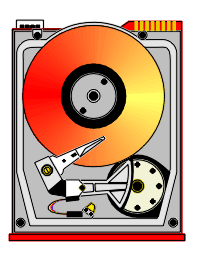
Mechanical Hard Drives
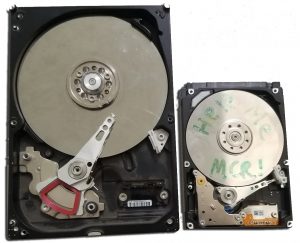
Why do Hard Drives Fail?
Issues with sectors
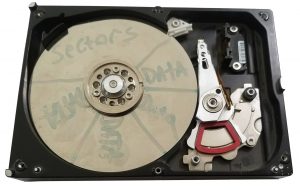
In computer disk storage, a sector is a subdivision of a track on a magnetic disk platter. Each sector stores a fixed amount of user-accessible data. Sometimes you can have a drive failing with “bad sectors”. Basically this can equate to just parts of the disk becoming unreadable. Sometimes drives have reallocation events where the drive notices sectors that are not reading well and starts moving the data to other healthier sectors in an effort to make the data more recoverable. Other times drives have “current pending sector count”errors where entire sectors have gone missing due to the drive not being able to read data on the disk.
Mechanical Failure
Hard drives that are not working properly are almost always mechanically failed. Essentially a hard drive has a platter that stores the data. A head that is attached to an actuator arm writes and reads the data with a tiny electromagnet. If the head becomes dislodged or un – calibrated it will cause serious read in write failures. In worst cases the head crashes into the platter.
Hard Drive Circuit Board Failure
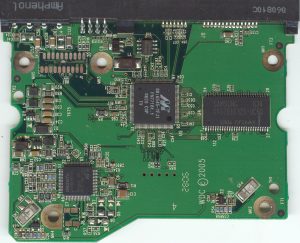
The PCB on a hard drive can fail due to shorts, liquid damage or a power surge. In witch case we can replace the board and transfer the ROM chips for recovery or fix the existing board itself. We can also fix the connectors on hard drives as well for data recovery.
ABOUT OUR SERVICE
Hardware Based Recovery
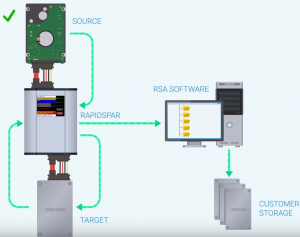
We use a hardware based recovery solution. Our machine runs a proprietary cloud based drive diagnostic system. We are able to scan the drive for errors, access a database of common issues, determine the issues with the drive and apply potential solutions. This tool allows us to send commands to the drive directly and communicate with the firmware to overcome issues with the drive. By being able to send commands when the drive gets hung up on a bad area to skip, this allows us to get unstuck and continue recovering useful data. We are also able to modify the type of recovery on the fly. If a drive is incredibly bad we can opt to skip all bad areas and try and recover as fast as possible to rescue the most data with the least stress on the drive. Afterward we can go back and “dig” bad sectors to get a more complete recovery. These are just a small example of things that make it superior to software recovery tools.
Why Software Solutions Fail
Most shops use software only based solutions. The problem with using software to recover data from failed drives is that it has a TON of limitations. Software has to deal with an environment that is fighting against failed drives. When you plug a drive into a computer a lot of things need to happen. The Operating System needs to detect the drive via the kernel, the file manager needs to mount the drive, then what ever software you use needs to access the drive to attempt data recovery. Problem is, when a drive needs to be mounted it cannot time out for more than roughly 300ms or it may not even show up to begin the process. This leads the tech to end up letting the customer know that the drive is unrecoverable then offer to outsource it for a ton of money when our solution could get the data with ease.
Limitations
While we have the capability to recover most drives there are limitations. Mechanical failure on the extreme end can require a drive to be physically opened. Some examples would be loud clicking or chirping sounds usually right after a large amount of trauma such as drops etc. In those extreme cases a clear room recovery service may be needed to open the drive so no dust can get in and damage the data recovery process. This does get costly but we can assist in getting it to a trusted facility if needed.
Advanced Techniques



We offer a variety of other data recovery methods such as head mapping where we turn off bad heads and recover what we can off the good heads, Firmware repair and logical data recovery solutions for drives that loose their file tree.
Why choose us?



Besides having recovered countless drives and helping countless customers over the last 10 years our capability is what sets up apart. We are able to get drives recovered from some really awful situations. We are informative, friendly and care about the importance of the data being recovered. We are by far the most cost effective option as well but success is more important in the situation. For every 3 drives that are sent off by other recovery companies at least 2 of those could be recovered in house saving time, money and worry.
THINGS NOT TO DO!
Before bringing your drive to us you may be tempted to try some DIY fixes to get your data. While we support and encourage people to fix, service and work on their own items, when it comes to data it’s not advised.
Many things people do make the data unrecoverable! The attempt itself ruins the chances of us getting your data.
::DO NOT RUN THE FACTORY RESTORE DISK OR RECOVERY:: DO NOT REINSTALL YOUR SYSTEM ::
YOUTUBE NIGHTMARES: If you find yourself looking to youtube for solutions on drive recovery you are setting yourself up likely for a bad time. Most common things we see people try that they “saw on youtube” are listed here:
Putting the drive in the freezer: A common video is that if you put your drive in a freezer it will make it work better long enough to rescue your data. This is a myth. This can lead to moisture in your drive (GAME OVER FOR DATA) or exacerbating what ever issue the drive has by trying to fiddle with a drive having a mechanical failure.
Opening the drive or loosing a screw: People advising you to physically open your drive are DANGEROUS. Drives are hermetically sealed to keep dust and debris under over 0.3 microns out. If dust, debris or god forbid a finger print gets on the platter of your drive then chances are that data recovery will become impossible. NEVER OPEN A HARD DRIVE.
Tapping or bumping your hard drive: There is a myth that giving your hard drive a little bump or tap will correct the issue with the drive. This is only making the situation WAY WORSE! Drives fail for a lot of reasons and this is not a solution. You will either cause more heads to fly off the actuator arms or cause one to crash into the platter!
Powering the drive on and off hoping it will come back: If your drive is having issues leaving it plugged in or power cycling it over and over again hoping it will come back to life is a bad idea! You are taking a failed or failing device and putting more load onto it in a hopeless effort to bring it back. Won’t work.
Running recovery software from a failing drive or saving to it: Running data recovery tools from a working but failing drive is no good. Saving anything or writing to a failing drive is worse. Don’t do it.
Putting a wet drive in rice: This myth that rice fixes electronics needs to go away. The issue with water damage is that when it drys it leaves behind hard minerals and causes corrosion. Lastly dry rice does not suck the moisture out and even if it did it still won’t help with corrosion . Most electronics fail on contact so drying them does not make the components magically work. Lastly it encourages people to wait while the corrosion does it’s damage and to make it worst after waiting people just plug it into power and fry it! Look, maybe a phone survived after being put into rice or something but it had nothing to do with rice, it was just dumb luck. RICE IS FOR DINNER NOT A TOOL.
Just bring the drive in to a professional if the data is important. If you want to practice data recovery do it on drive with data you don’t care about not one you need data from.
Things to do if your drive is failed.
If your drive is failed or failing these are some things you should do.
Power off the device and stop using it immediately.
If you see warning signs such as freezing or windows shut down the computer.
If you have a backup check it on another computer before bringing it in for data recovery or we can check it for you to see if it’s necessary.
Check all iCloud and Google drive or other online storage to make sure the files you need are not there already.
Bring the drive in for a free evaluation.
Do you charge if my data is not recovered?
We do not charge if we cannot save your data. If we get a partial recovery you may take a look at it and decide if you want to pay for it. We only offer solution based pricing.
What is the turn around?
Turn around depends on the amount of data, que and severity of the drive. Between 1 and 2 weeks usually.
Where will my recovered data be put?
We require a storage device before starting a data recovery. External hard drives are ideal for storing the recovered files. We sell them or you can provide your own. We can also do a thumb drive but only if it has enough space.
We will not put data on optical disks such as CD’s or DVD’s etc.
What if my data cannot be recovered?
This depends on the situation. However, we do have one other option for data recovery we can pursue and discuss if we cannot get the data in house as a last resort. It just becomes less cost effective and we can discuss options should this be the case.
Will my data be safe? What about privacy?
We take safety as a top priority. All drives are stored in a safe when we are closed. All drives have a chain of command.
Your data privacy is #1 . We have no problem signing a NDA or doing HIPPA work.
We use your target drive and don’t store data locally on our machines. This is why we require a target drive when we start. In the off case we do need to use our machine the data is securely erased when done.
We do a blind back up. This means we don’t see the content of the back up as it happens. We see the blocks of data moving not what they are. Our tool tells us if there is corruption on certain files however and we save it for you to view.
We are not interested in your files other then saving them and most of these methods we use such as a blind back up are actually to protect us from your data and not the other way around.


